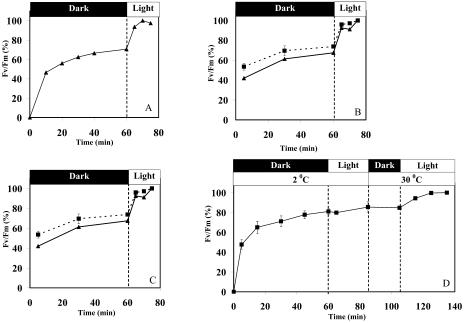Figure 5.
Effect of light, temperature, DCMU, and chloramphenicol on the development of Fv/Fm in crusts after wetting. Dried crusts were rehydrated in the dark and the Fv/Fm values measured as a function of time. At the indicated time points, the samples were transferred to the light (30 μmol photon m−2 s−1) and incubated until a plateau Fv/Fm value was reached. The data are presented as percent of the maximal PSII activity obtained. A, Samples rehydrated with distilled water at 25°C. B, Solid line, samples rehydrated as above; dashed lines, samples rehydrated in presence of 50 μm DCMU. C, Samples rehydrated as in A in the absence (solid line) or presence of 100 μg mL−1 chloramphenicol (dashed lines). D, Sample rehydrated at 2°C and then transferred to the light for 20 min. This was followed by warming the crust to 30°C and illuminated for an additional 30 min. The data are presented as percent of the final values to demonstrate the similarity of the effect of rehydration in the dark or light, in samples that contained different amounts of cyanobacteria and vary to some extent in the initial Fv/Fm values. In these experiments (n = 4), the maximal Fv/Fm values (100%) were in the range of 0.45 to 0.55. The sds are provided only in cases where it was larger than 5% of the average.

